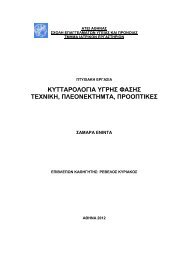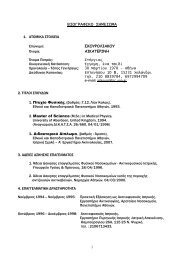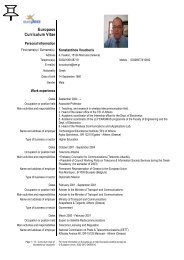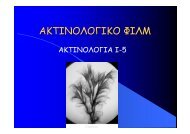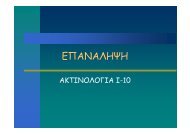Grigoris Kaltsas
Grigoris Kaltsas
Grigoris Kaltsas
You also want an ePaper? Increase the reach of your titles
YUMPU automatically turns print PDFs into web optimized ePapers that Google loves.
Curriculum Vitae<br />
Dr <strong>Grigoris</strong> KALTSAS received his B.Sc. degree in Physics from National University of Athens<br />
in 1993. He joined the Institute of Microelectronics of National Center for Scientific Research<br />
(NCSR) "Demokritos" in 1993 as a Ph.D. student, after he has obtained a corresponding scholarship<br />
from the Institute. He received his Ph.D. entitled “Integrated gas and gas flow sensors fabricated by<br />
using porous silicon technology”, from the National Technical University of Athens (School of<br />
Applied Mathematical and Physical Sciences) in 1998. He joined the Department of Electronics of<br />
the Technological Educational Institute of Athens (TEI-A) in 2003 as Assistant Professor and he is<br />
now Professor in the same Department. He is also affiliated (since 2003) with the Institute of<br />
Microelectronics of NCSR “Demokritos”, as a research associate, having a close collaboration with<br />
several members of the Institute staff.<br />
Dr. G. <strong>Kaltsas</strong> has participated and coordinated several European and National research projects<br />
funded by various foundations (EU, GSRT, Ministry of Education, etc) and industries (Unilever<br />
UK, i-Tax). He has collaborated with many European research groups from various countries within<br />
the frame of several projects. He has also participated in various committees and boards related to<br />
electronics – microsystems - sensors research and education.<br />
He has published over 100 papers in refereed journals and major conferences and he is an author of<br />
5 patents, two of them being PCTs. He has given 3 invited talks in major international conferences<br />
in the field of microsystems – microfluidic devices and sensor technology. In 2004 he has been<br />
awarded from the minister of development by the General Secretariat for Research and Technology<br />
for the patent “Flow meter and special designed packaging for use in medical equipment for breath<br />
control”, for the contribution to the technological progress of the country. He has over 350 citations<br />
(excluding self-citations) with an h-index of 11.<br />
He has developed a novel integrated flow sensor, which is currently in the commercialization stage.<br />
His ongoing research resulted to an innovative micro-PCB integration technology, which was the<br />
basic technique for the fabrication of various novel sensing microsystems (microfluidic sensors,<br />
accelerometers, position sensors etc). The microfluidic applications of the specific technology drew<br />
the interest of the international community, thus a related talk awarded with the “Tony B. Academic<br />
Travel Award for up-and-coming researchers who have demonstrated outstanding achievement in<br />
laboratory science and technology” in the SLAS 2012 conference (San Diego, CA, USA, Feb<br />
2012). The specific technology is currently being applied to flexible substrates, so as flexible<br />
microsystems to be realized.<br />
Dr. G. <strong>Kaltsas</strong> is also active in the research related to bio-sensing and bio-analysis application of<br />
microfluidic systems. Since 2011 he has been nominated as the head of EMBIO Diagnostics Ltd<br />
(EMBIO) (http://www.embiodiagnostics.com/) Scientific Board, which is the world leader in cellbased<br />
biosensors and an expert in the dissemination of biosensor technology at a global scale. Based<br />
on its unique technological advantage, EMBIO envisions the revolutionizing of medical<br />
diagnostics, biological warfare detection, food safety and agricultural production worldwide.<br />
EMBIO has pioneered the creation of next generation cellular biosensors, including the Bioelectric<br />
Recognition Assay (BERA) and the Molecular Identification through Membrane Engineering, also<br />
known as MIME artificial cell technology.<br />
He is the founder and the head of the “Microsystems, Sensors and Embedded Devices<br />
(microSENSES)” laboratory. The microSENSES laboratory was established in order to enhance the<br />
research activities in the general field of microsystems, sensors, microfluidics and embedded<br />
devices, while it aims at building-up an internationally competitive research Laboratory.<br />
MicroSENSES includes 7 members of academic staff mainly from the Electronics Department of<br />
TEI-A, 2 post-doc scientists, and 6 students. It provides a challenging work environment, where<br />
1
people contribute to common objectives while responding to individual needs and aspirations. A<br />
further laboratory objective is to transfer the capabilities and knowledge from the mechanical<br />
sciences to biologists and medical researchers. The laboratory mainly focuses in the following<br />
research fields: Development of microsystems, Fabrication and evaluation of integrated thermal<br />
sensors, Development of new microsystem technologies, Development of integrated bio-sensors<br />
and bio-systems, Microsystems modeling and simulation, Microfluidic devices - Applications to<br />
health and biology, Flexible substrate technologies - Development and evaluation of<br />
microstructures, Embedded systems – microcontrollers, Electronic sensor interfacing.<br />
He was the head of the organizing committee (Technical Program Chairman) of the international<br />
scientific conference “Eurosensors 2011”. The conference took place in September 2011 at the<br />
Megaron - The Athens Concert Hall. It was attended by more than 550 participants, coming from<br />
the major European and international universities, research centers and companies. The technical<br />
program consisted of 434 contributions originated from 46 countries.<br />
He is also a member of the International Program Committee for the MNE conference (Micro and<br />
Nano Engineering) form 2008 and a member of the International Program Committee of the<br />
“Eurosensors” conference from 2010. He is also a member of “Regmina” research project advisory<br />
board.<br />
He has participated in several scientific committee for various national/international conferences in<br />
the general field of microsystems and sensors. He has presented several talks in various<br />
organizations regarding sensors, microsystems and microfluidics research and development.<br />
He is an editor for ISRN Electronics Journal and Elsevier-Procedia Engineering (Vol. 25), while he<br />
is an active referee in major journals in the microsystem area (IEEE Sensors Journal,<br />
Microelectronic Engineering, Elsevier “Measurement” etc).<br />
Dr. G. <strong>Kaltsas</strong> has been also elected as the head of the “Computational and Control Systems”<br />
division of the Electronics department of TEI-A, since 2010. He is also a member of the General<br />
Research Committee of the School of Technology Applications of TEI-A, for several years. He is<br />
participating (one of the two members) in the Coordinating Committee of the new MSc program of<br />
the Department of Electronics of the TEI-A entitled "Design and Development of Advanced<br />
Electronic Systems", which will be started from October 2012.<br />
According to Greek legislation Technological Educational Institutions cannot provide PhD<br />
diplomas. However Dr. G. <strong>Kaltsas</strong> participated in two PhD Supervisory Committees of the National<br />
Technical University of Athens:<br />
• “Integrated hybridic microfluidic multi-sensors devices in meso-scale”, National Technical<br />
University of Athens, School of Applied Mathematical and Physical Sciences.<br />
• “Active flow control, by using sensor networks”, National Technical University of Athens, School<br />
of Mechanical Engineering.<br />
His research interests are mainly focusing in the following topics:<br />
Microsystems - Microfluidic devices<br />
Fabrication and evaluation of integrated thermal sensors<br />
Development of new microsystem technologies<br />
Flexible substrate technologies<br />
Development of integrated bio-sensors and bio-systems<br />
Microsystems modeling and simulation<br />
Embedded systems – microcontrollers - Electronic sensor interfacing<br />
Web page: http://users.teiath.gr/microsenses/<br />
2
List of Most Significant Publications<br />
[1] E. Larou, I. Yiakoumettis, G. <strong>Kaltsas</strong>, A. Petropoulos, P. Skandamis, S. Kintzios, “High throughput<br />
cellular biosensor for the ultra-sensitive, ultra-rapid detection of aflatoxin M1” Food Control<br />
(accepted).<br />
[2] P. Blouchos, E. Voumvouraki, A. Moschos, G. <strong>Kaltsas</strong>, P. Dimitrakis, S. Kintzios, “Membraneengineered<br />
bacterial cells as promising biorecognition elements for the detection of 2,4,6trichloroanisole<br />
in wine” Biosensors 2012, Cancun, Mexico, May 15-18, 2012.<br />
[3] A. Petropoulos, D. N. Pagonis, G. <strong>Kaltsas</strong>, “A PCB integrated wide range microfluidic flow sensor<br />
with controllable sensitivity” Society for Laboratory Automation and Screening (SLAS 2012), San<br />
Diego Convention Center, San Diego, CA, USA, Feb 4-8, 2012 (“Tony B. Academic Travel Award”<br />
for up-and-coming researchers who have demonstrated outstanding achievement in laboratory<br />
science and technology).<br />
[4] G. P. Patsis, A. Petropoulos, G. <strong>Kaltsas</strong>, “Modelling and evaluation of a thermal microfluidic sensor<br />
fabricated on plastic substrate” Microsystem Technologies, 18 (3), (2012) 359-364.<br />
[5] D. N. Pagonis, A. Petropoulos, G. <strong>Kaltsas</strong>, “A pumping actuator implemented on a PCB substrate by<br />
employing water electrolysis” Microelectronic Engineering 95 (2012) 65–70.<br />
[6] A. Petropoulos, G. <strong>Kaltsas</strong>, “Study and evaluation of a PCB-MEMS liquid microflow sensor” Sensors<br />
10(10), (2010) 8981-9001.<br />
[7] A. Petropoulos, G. <strong>Kaltsas</strong>, D. Randjelovic, E. Gogolides, “Study of Flow And Pressure Field In<br />
Microchannels With Various Crossection Areas” Microelectronic Engineering 87 (2010) 827–829.<br />
[8] G. <strong>Kaltsas</strong>, “A new technology which allows direct integration on flexible substrates – Application to<br />
microfluidics and various thermal sensors” 2nd REGMINA workshop on MEMS and NEMS<br />
technologies, Belgrade, Serbia, Apr 18-20, 2011. (Invited talk)<br />
[9] D. Randjelović, Z. Djurić, A. Petropoulos, G. <strong>Kaltsas</strong>, Z. Lazića, M. Popovića “Analytical modelling<br />
of thermopile based flow sensor and verification with experimental results” Microelectronic<br />
Engineering 86 (2009) 1293-1296.<br />
[10] K. Kontakis, A. Petropoulos, G. <strong>Kaltsas</strong>, T. Speliotis, E. Gogolides “A novel microfluidic integration<br />
technology for PCB-based devices: Application to microflow sensing” Microelectronic Engineering<br />
86 (2009) 1382-1384.<br />
[11] A. Petropoulos, D. Goustouridis, T. Speliotes, G. <strong>Kaltsas</strong> “Demonstration of a new technology which<br />
allows direct sensor integration on flexible substrates” European Physical Journal - Applied Physics,<br />
46, 12507 (2009).<br />
[12] A. Petropoulos, G. <strong>Kaltsas</strong>, D. Goustouridis, “A novel system for displacement sensing, integrated on<br />
a plastic substrate”, Microelectronics Journal, 40 (2009) 1387– 1392.<br />
[13] A. Petropoulos, G. <strong>Kaltsas</strong>, T. Speliotis and A. G. Nassiopoulou, “Evaluation of a gas flow sensor<br />
implemented on organic substrate” Phys. Stat. Sol. (c), 5, No. 12, (2008) 3839–3842.<br />
[14] A. Petropoulos, G.<strong>Kaltsas</strong>, and A.G. Nassiopoulou, “A thermal vacuum sensor fabricated on plastic<br />
substrate – Study in various operation modes” Phys. Stat. Sol. (a), 205, No. 11, (2008) 2639–2642.<br />
[15] P. Katsikogiannis, E. Zervas, and G. <strong>Kaltsas</strong>, “A wireless sensor network for building structural health<br />
monitoring and seismic detection” Phys. Stat. Sol. (c), 5, No. 12, (2008) 3834–3838.<br />
[16] Ch. Stamatopoulos, A. Petropoulos, D. S. Mathioulakis, G. <strong>Kaltsas</strong>, “Study of an integrated thermal<br />
sensor in different operational modes, under laminar, transitional and turbulent flow regimes”,<br />
Experimental Thermal and Fluid Science, (32) 8 (2008) pp. 1687-1693.<br />
[17] D. Randjelovic, A. Petropoulos, G. <strong>Kaltsas</strong>, M. Stojanovic, Z. Lazic, Z. Djuric and M. Matic,<br />
“Multipurpose MEMS Thermal Sensor Based On Thermopiles”, Sensors and Actuators A 141 (2008)<br />
404-413.<br />
[18] G. <strong>Kaltsas</strong>, A. Petropoulos, K. Tsougeni, D. N. Pagonis, T. Speliotis, E. Gogolides and A. G.<br />
Nassiopoulou, “A novel microfabrication technology on organic substrates - Application to a thermal<br />
flow sensor”, Journal of Physics: C. Series, 92 (2007) 012046.<br />
[19] G. <strong>Kaltsas</strong>, P. Katsikogiannis, P. Asimakopoulos and A. G. Nassiopoulou, “A smart flow<br />
measurement system for flow evaluation with multiple signals in different operation modes”, Meas.<br />
Sci. Technol. 18 (2007) 3617-3624.<br />
[20] D. N. Pagonis, A. Petropoulos, G. <strong>Kaltsas</strong>, A. G. Nassiopoulou and A. Tserepi “Novel microfluidic<br />
flow sensor based on a microchannel capped by porous silicon” Phys. Stat. Sol. (a), 204, Νο 5, (2007)<br />
pp. 1474–1479.<br />
[21] D. Goustouridis, G. <strong>Kaltsas</strong>, A. G. Nassiopoulou, “A Silicon Thermal Accelerometer Without Solid<br />
Proof Mass Using Porous Silicon Thermal Isolation”, IEEE Sensors Journal, 7, (7), (2007) pp. 983-<br />
989.<br />
3
[22] G. <strong>Kaltsas</strong>, D. Goustouridis and A. G. Nassiopoulou “A Thermal Convective Accelerometer System<br />
Based On A Silicon Sensor – Study And Packaging”, Sensors and Actuators A 132 (2006) 147-153.<br />
[23] G. <strong>Kaltsas</strong>, D. Goustouridis, A. G. Nassiopoulou and D. Tsoukalas, “Combination of integrated<br />
thermal flow and capacitive pressure sensors for high sensitivity flow measurements in both laminar<br />
and turbulent regions” Journal of Physics: C. Series, 10 (2005) pp. 277-280.<br />
[24] P. Asimakopoulos, G. <strong>Kaltsas</strong> and A. G. Nassiopoulou, “A microcontroller-based interface circuit for<br />
data acquisition and control of a micromechanical thermal flow sensor”, Journal of Physics: C.<br />
Series, 10 (2005) pp. 301-304.<br />
[25] D. N. Pagonis, G. <strong>Kaltsas</strong>, A. G. Nassiopoulou, “Fabrication and testing of an integrated thermal flow<br />
sensor employing thermal isolation by porous silicon membrane over air cavity”, J. of<br />
Micromechanics and Microengineering , 14 No 6 (2004) pp. 793-797.<br />
[26] D. N. Pagonis, A. G. Nassiopoulou and G. <strong>Kaltsas</strong>, “Porous Silicon Membranes Over Cavity For<br />
Efficient Local Thermal Isolation On Silicon For Application In Si Thermal Sensors”, J. Electrochem.<br />
Soc., 151 (8) H174-H179 (2004).<br />
[27] G. <strong>Kaltsas</strong> and A. G. Nassiopoulou, “Gas flow meter for applications in medical equipment for<br />
respiratory control - Study of the package and housing” Sensors and Actuators A, 100 (2004) pp. 413-<br />
422.<br />
[28] G. <strong>Kaltsas</strong>, “Porous Silicon Micromachining”, 4 th Int. Con. on Porous Semiconductors Science And<br />
Technology (PSST 2004), Cullera-Valencia, Spain, March 14-19, 2004 (Invited talk).<br />
[29] P. Asimakopoulos, G. <strong>Kaltsas</strong>, A. G. Nassiopoulou “Investigation of different operation modes of a<br />
micromechanical thermal flow sensor, using a microcontroller-based interface circuit”, Second<br />
Conference on Microelectronics Microsystems Nanotechnology (MMN 2004), Athens, Greece, Nov.<br />
14-17, 2004 (Best poster award).<br />
[30] G. <strong>Kaltsas</strong>, D. N. Pagonis, A. G. Nassiopoulou, “Planar CMOS Compatible Process For The<br />
Fabrication of Buried Microchannels In Silicon, Using Porous Silicon Technology”, IEEE J.<br />
Microelectromech. Syst , 12 (6), (2003) pp. 863-872.<br />
[31] D. Pagonis, G. <strong>Kaltsas</strong> and A. G. Nassiopoulou, “Implantation Masking Technology for Selective<br />
Porous Silicon Formation”, Phys. Stat. Sol. (a), 197, Νο 1, (2003) pp. 241-245.<br />
[32] G. <strong>Kaltsas</strong>, A. A. Nassiopoulos and A. G. Nassiopoulou, “Characterization of a Silicon Thermal Gas-<br />
Flow Sensor With Porous Silicon Thermal Isolation”, IEEE Sensors Journal, 2, No 5, (2002) pp.<br />
463-475.<br />
[33] A. G. Nassiopoulou and G. <strong>Kaltsas</strong>, “Porous Silicon as an Effective Material for Thermal Isolation on<br />
Bulk Crystalline Silicon”, Phys. Stat. Sol. (a), 182, No 1, (2000) pp. 307-311.<br />
[34] H. Talaat, S. Negm, H. E. Schaffer, G. <strong>Kaltsas</strong>, A.G. Nassiopoulou, “Micro-Raman Analysis of<br />
Polysilicon Membranes Deposited on Porous Silicon Channels”, Journal of Non-Crystalline Solids,<br />
266-269 (2000) pp. 1345-1349.<br />
[35] G. <strong>Kaltsas</strong>, A. G. Nassiopoulou, “Novel C-MOS Compatible Monolithic Silicon Gas Flow Sensor<br />
With Porous Silicon Thermal Isolation”, Sensors and Actuators Α, 76 (1999) pp. 133-138.<br />
[36] G. <strong>Kaltsas</strong>, A. G. Nassiopoulou, M. Siakavellas, E. Anastassakis, “Stress Effect on Suspended<br />
Polycrystalline Silicon Membranes Fabricated by Micromachining of Porous Silicon”, Sensors and<br />
Actuators A, Vol 68, No 1-3, (1998) pp. 429-434.<br />
[37] G. <strong>Kaltsas</strong>, A. G. Nassiopoulos, “Frontside Bulk Silicon Micromachining Using Porous-Silicon<br />
Technology”, Sensors and Actuators A, 65 (1998) p.175-179.<br />
[38] M. Siakavellas, E. Anastassakis, G. <strong>Kaltsas</strong>, A. G. Nassiopoulos, “Micro-Raman Characterization of<br />
Stress Distribution Within Free Standing Mono- and Poly-Crystalline Silicon Membranes”, Microelec.<br />
Eng, 41/42 (1998) pp. 469-472.<br />
[39] D. Papadimitriou, Y. S. Raptis, A. G. Nassiopoulou and G. <strong>Kaltsas</strong>, “Porous Silicon of Variable<br />
Porosity Under High Hydrostatic Pressure: Raman and Photoluminescence Studies”, Phys. Stat. Sol.<br />
(a) 165, No. 1, (1998) pp. 43-48.<br />
[40] G. <strong>Kaltsas</strong>, N. Glezos, E. Valamontes and A. G. Nassiopoulou, “Thickness Determination of Thin<br />
Films Based on X-Ray Signal Decay Lay”, Surface and Interface Analysis, 26, No 12, (1998) pp.<br />
876-884<br />
[41] G. <strong>Kaltsas</strong> and A. G. Nassiopoulou, “Novel Integrated Gas Flow Sensor Based on Porous Silicon<br />
Technology”, EUROSENSORS XII, Southampton, UK, Sept. 13-16, 1998 (Presentation in a special<br />
session for important new results).<br />
[42] G. <strong>Kaltsas</strong>, A. G. Nassiopoulos, “Bulk Silicon Micromachining Using Porous Silicon Sacrificial<br />
Layers”, Microelec. Eng. 35, (1997) pp. 397-400.<br />
4
Significant Research Achievements In The Last 10 Years<br />
Scientific Publications:<br />
Patents : 5 (2 PCTs)<br />
International scientific Journals (ISI index): 42<br />
International Conference proceedings: 61<br />
National Conference proceedings: 12<br />
Citations:<br />
At least 443 total citations (h-index: 12), with 355 citations excluding the selected author (h-index: 11) and<br />
291 citations excluding all authors (h-index: 10).<br />
Source: SciVerse Scopus (http://www.scopus.com)<br />
Additionally parts of the scientific publications are referred in the following scientific books:<br />
“Materials & Process Integration for MEMS”, Kluwer, 2002, ISBN: 1402071752.<br />
“MEMS Mechanical Sensors”, Artech House, 2004, ISBN: 1-58053-536-4.<br />
“MEMS: a practical guide to design, analysis, and applications” Jointly published with William<br />
Andrew, Norwich, New York, USA, 2006, ISBN-10: 0815514972<br />
International Patents<br />
[1] “Integrated Gas Flow Sensor Based on Porous Silicon Micromachining”<br />
PCT/GR97/00040, WIPO: 12/11/1998, EU Ν ο 979133469, 7/11/1999<br />
Inventors: A. Nassiopoulou, G. <strong>Kaltsas</strong><br />
[2] “Low Power Silicon Thermal Sensors and Microfluidic Devices based on the use of Porous Silicon<br />
Sealed Air Cavity technology or Microchannel technology”<br />
PCT/GR03/00003<br />
Inventors: A. Nassiopoulou, G. <strong>Kaltsas</strong>, D. Pagonis<br />
National Patents<br />
[1] “Flow meter and special designed packaging for use in medical equipment for breath control”<br />
ΟΒΙ Number: 1004237, Inventors: A. Nassiopoulou, G. <strong>Kaltsas</strong><br />
[2] “Integrated thermal low power silicon sensors and microfluidic systems fabricated by sealed<br />
cavity through porous silicon or microchannel technology”<br />
ΟΒΙ Number: 1004106, Inventors: G. <strong>Kaltsas</strong>, D. Pagonis, A. Nassiopoulou<br />
[3] “Gas flow sensor, integrated through porous silicon technology”<br />
ΟΒΙ Number: 1003010, Inventors: G. <strong>Kaltsas</strong>, A. Nassiopoulou.<br />
Organization of the International Conference "Eurosensors 2011"<br />
Head of the organizing committee (Technical Program Chairman) of the international scientific conference<br />
“Eurosensors 2011”. The conference took place in September 2011 at the Megaron - The Athens Concert<br />
Hall. It was attended by more than 550 participants, coming from the major European and international<br />
universities, research centers and companies. The technical program consisted of 434 contributions<br />
originated from 46 countries. Among them, four keynote lectures were presented by world-wide recognized<br />
experts, focused in cutting edge and emerging technologies. Moreover eleven invited talks were given.<br />
Participation in two PhD Supervisory Committees<br />
“Integrated hybridic microfluidic multi-sensors devices in meso-scale”, National Technical University<br />
of Athens, School of Applied Mathematical and Physical Sciences.<br />
“Active flow control, by using sensor networks”, National Technical University of Athens, School of<br />
Mechanical Engineering.<br />
Foundation of the research laboratory “Microsystems, Sensors and Embedded Devices<br />
(microSENSES)"<br />
The microSENSES laboratory belongs to the Department of Electronics of TEI-A. It was established in 2009<br />
in order to host research activities in the general field of microsystems, sensors and embedded devices. The<br />
laboratory mainly focuses in the following research fields:<br />
Development of microsystems<br />
5
Fabrication and evaluation of integrated thermal sensors<br />
Development of integrated accelerometers<br />
Development of new microsystem technologies<br />
Development of integrated bio-sensors and bio-systems<br />
Microsystems modeling and simulation<br />
Microfluidic devices - Applications to health and biology<br />
Flexible substrate technologies - Development and evaluation of microstructures<br />
Embedded systems - microcontrollers<br />
Electronic sensor interfacing<br />
Sensor networks<br />
Laboratory objectives:<br />
To enhance research in the general field of Microsystems, Microfluidics and Embedded devices.<br />
To develop innovative technologies in microfluidics and flexible electronics sectors.<br />
To build-up an internationally competitive research Laboratory.<br />
To provide a challenging work environment, where people contribute to common objectives while<br />
responding to individual needs and aspirations.<br />
To transfer the capabilities and knowledge from the mechanical sciences to biologists and medical<br />
researchers.<br />
(For more info please refer to: http://users.teiath.gr/microsenses/)<br />
EMBIO Diagnostics Ltd (EMBIO) Scientific Board<br />
Since 03/2011, Dr. G. <strong>Kaltsas</strong> has been nominated as the head of EMBIO Diagnostics Ltd (EMBIO)<br />
Scientific Board (http://www.embiodiagnostics.com/). The specific company provides leading edge products<br />
and services in the area of biological systems and devices.<br />
Editor – Reviewer in international scientific journals<br />
Editor in: ISRN Electronics<br />
Elsevier-Procedia Engineering, Volume 25<br />
Reviewer in: IEEE - “Sensors Journal”<br />
IEEE/ASME - “Journal of Microelectromechanical Systems”<br />
Elsevier - “Sensors and Actuators A: Physical”<br />
Elsevier - “Microelectronic Engineering”<br />
Elsevier - “Measurement”<br />
Elsevier - “International Journal of Thermal Sciences”<br />
MDPI - Sensors<br />
MDPI - Micromachines<br />
Cambridge University Press - “The European Physical Journal - Applied Physics<br />
(EPJAP)”<br />
Other Distinctions<br />
Head of the “Computational and Control Systems” division of the Electronics department at TEI of<br />
Athens.<br />
GSRT award for the patent “Flow meter and special designed packaging for use in medical equipment<br />
for breath control” given by the minister of development.<br />
Member of the International Program Committee of the “Micro-and Nano-Engineering (ΜΝΕ)”<br />
conference from 2008.<br />
Member of the International Program Committee of the “Eurosensors” conference from 2010.<br />
Member of “Regmina” research project advisory board.<br />
Member of the scientific committee for several national/international conferences.<br />
Participation in various major committees of TEI-A for several years (General research committee,<br />
master-degree committee etc).<br />
6
Coordination of Research Projects<br />
List of Research Projects<br />
Title: ARCHIMIDES II: “Development of an electromechanical device for controlling of physical<br />
parameters by combining microelectronics and PCB technology”<br />
Institution: TEI of Athens, Department of Electronics<br />
Coordinator: Dr. G. <strong>Kaltsas</strong><br />
Budget: 70.000 Euro<br />
Duration: 01/05 – 12/07<br />
Title: PENED: “Integrated hybridic microfluidic multi-sensors devices in meso-scale”<br />
Institution: TEI of Athens, Department of Electronics<br />
Coordinator: Dr. G. <strong>Kaltsas</strong><br />
Budget: 66.000 Euro<br />
Duration: 12/05 – 06/09<br />
Title: Greece-France Bilateral Collaboration: “Study and fabrication of a diphasic micro-cooler (DMC)<br />
using thermal integrated sensors (flow, pressure and temperature)”<br />
Institution: TEI of Athens, Department of Electronics<br />
Coordinator: Dr. G. <strong>Kaltsas</strong><br />
Budget: 12.400 Euro<br />
Duration: 12/06 – 03/08<br />
Title: Industrial project (funded by Unilever UK): “Development of a liquid flow system for extremely low<br />
flow velocities”<br />
Institution: NSCR “Demokritos”, Inst. of Microelectronics<br />
Coordinator: Dr. A. Nassiopoulou (IMEL), Dr. G. <strong>Kaltsas</strong> (TEI-A)<br />
Budget: 44.214 Euro<br />
Duration: 03/06 – 01/07<br />
Title: Industrial project (funded by i-Tax): Study, design and fabrication of a wireless transmission system<br />
for taxation data of cash machines via short message service (SMS)<br />
Institution: TEI of Athens, MicroSenses Lab<br />
Coordinator: Dr. G. <strong>Kaltsas</strong><br />
Budget: 7.400 Euro<br />
Duration: 05/11 – 11/11<br />
Title: Athena (TEI project): “Study of an integrated thermal accelerometer”<br />
Institution: TEI of Athens, MicroSenses Lab<br />
Coordinator: Dr. G. <strong>Kaltsas</strong><br />
Budget: 3.000 Euro<br />
Duration: 01/05 – 01/07<br />
Participation in Research Projects<br />
Title: COST Action FP1104: “New possibilities for print media and packaging - combining print with<br />
digital”<br />
Institution: VTT, Finland<br />
Coordinator: Dr Anu Seisto<br />
Budget: 400.000 Euro<br />
Duration: 05/12 – 05/14<br />
Title: DISFER: DIstributed Sensor systems For Emergency Response<br />
Institution: Athens University of Economics and Business<br />
Coordinator: Prof. Vana Kalogeraki<br />
Budget: 560.000 Euro<br />
Duration: 01/12 – 12/13<br />
7
Title: FP7-BioliSME: «Speedy system for sampling and detecting Listeria monocytogenes in agro-food and<br />
related European industries»<br />
Institution: Asociación de Investigación de la Industria Agroalimentaria<br />
Coordinator: Jose Belenguer<br />
Budget: 1.015.000 Euro<br />
Duration: 06/09 – 12/11<br />
Title: PEBE 2009: “Measurement of shear stress in the interface between fluid-solid through an innovative<br />
flexible thermal microsensor”<br />
Institution: National Technical University of Athens<br />
Coordinator: Prof. D. Mathioulakis<br />
Budget: 15.000 Euro<br />
Duration: 01/10 – 06/12<br />
Title: ARCHIMIDES I: “Electromagnetic distortions and correlation with earthquakes”<br />
Institution: TEI of Athens, Department of Electronics<br />
Coordinator: Prof. K. Nomikos<br />
Budget: 51.623 Euro<br />
Duration: 02/04 – 08/06<br />
Title: ARCHIMIDES I: “Automatic characterization, simulation and theoretical study of nano-structures and<br />
electrical devices”<br />
Institution: TEI of Chalkida, General Dep. of Applied Sciences<br />
Coordinator: Prof. X. Zianni<br />
Budget: 50.435 Euro<br />
Duration: 03/04 – 08/06<br />
Title: FP5 - “Sensor array for fast explosion proof gas monitoring”<br />
Institution: University College Cork, National University of Ireland.<br />
Coordinator: Dr. Bill LANE<br />
Budget: 1.530.345 Euro<br />
Duration: 04/00 – 09/03<br />
Title: ESPRIT-INCO-PST-SENSORS: “Integrated gas flow and gas sensors by using porous silicon<br />
micromachining”<br />
Institution: NSCR “Demokritos”, Inst. of Microelectronics<br />
Coordinator: Dr. A. Nassiopoulou<br />
Budget: 320.000 Euro<br />
Duration: 03/96 – 07/99<br />
Title: PENED: “Real time study of seismic electric anisotropy and application in earthquakes prediction”<br />
Institution: National Observatory of Athens, Geodynamic Inst.<br />
Coordinator: Dr. G. Stavrakakis<br />
Duration: 07/96 – 07/99<br />
Title: EPET II: “Development and Applications of High-Tc superconductors”<br />
Institution: NSCR “Demokritos”, Inst. of Microelectronics<br />
Coordinator: Dr. A. Nassiopoulou<br />
Duration: 02/96 – 02/97<br />
Title: ESPRIT-EOLIS: Emission of light in silicon<br />
Institution: CRMC-CNRS<br />
Coordinator: Prof. F. Arnaud d'Avitaya<br />
Duration: 03/94 – 03/96<br />
8



